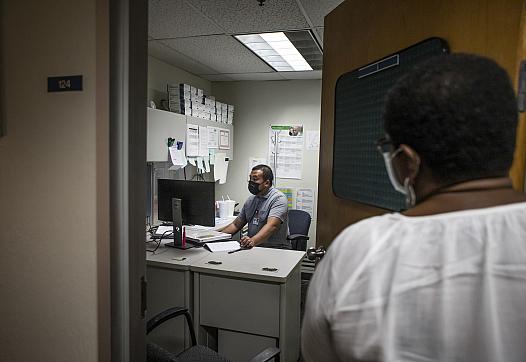Community health workers hit the streets to battle the surge in congenital syphilis
This story was originally published in CalMatters with support from the 2022 California Fellowship.

A formerly homeless mother, Cassidy, holds her child in her apartment in Redding on Sept. 20, 2022. Like many mothers who contract syphilis, Cassidy struggled with meth and alcohol addiction. She was able to get treatment from the Shasta Community Health Center street medicine team and help to secure temporary housing during her pregnancy and manage her alcohol withdrawal.
Photo by Larry Valenzuela, CalMatters/CatchLight Local.
Cassidy started crying before she even knew what her new one-bedroom apartment looked like. At 27 she had already spent nearly a third of her life in varying stages of homelessness — most recently housed in a temporary hotel room for pregnant women.
“We did it,” Cassidy said softly, looking down at her two-month-old daughter napping in a Minnie Mouse bouncy chair at her feet. “It took a long time.”
Ten months prior, Cassidy was living in a motel in Redding, California. She was pregnant, addicted to alcohol and methamphetamine, and scared of losing her child. She also had been recently treated for syphilis, a potentially life-threatening infection for an unborn child. CalMatters agreed to identify her only as Cassidy in order to share her story.
Most stories like Cassidy’s don’t end happily. Guiding her through a healthy pregnancy required breaking down the silos that traditionally separate health care from substance use treatment, mental health services, housing navigation and other social programs. Across the state, public health departments and community health centers are struggling to do just that. Some have created teams of clinicians and case workers to manage patients with complex socioeconomic needs.
“Housing is health care,” said Dr. Kyle Patton, medical director of the HOPE street medicine team at Shasta Community Health Center. Cassidy, who lost her job as a housekeeper during the pandemic, was at risk of ending up where many unhoused people in Redding camp, under the Cypress Street Bridge, a dangerous place for a pregnant woman.
The HOPE team — which includes doctors, nurses, case workers, substance abuse counselors, and psychiatric nurse practitioners — moved Cassidy into a long-term motel, set up appointments with the health center’s maternity clinic, and started treating her alcohol withdrawal.

Dr. Kyle Patton waiting for his unhoused patient outside their encampment in Redding on Sept. 20, 2022. The patient reached out to Patton for medical attention. Photo by Larry Valenzuela, CalMatters/CatchLight Local
“It was really when we addressed some of the ‘Where am I going to live’ component to things, that we were then able to really kind of hustle and get her caught up in a lot of her routine prenatal care,” Patton said.
Cassidy is one of a growing number of women across the state with little to no access to prenatal care, which has led, in part, to skyrocketing rates of maternal and congenital syphilis, the likes of which haven’t been seen in two decades. Congenital syphilis occurs when the infection is passed from mother to fetus during pregnancy. More than half of women who passed the infection to their child reported receiving no or delayed prenatal care, according to a California Department of Public Health analysis of 2018 data.
Barriers to prenatal care can include a lack of transportation, insurance or translation services, but by far, the most challenging cases are those like Cassidy’s, wrapped up in meth addiction and housing instability. Half of pregnant people with syphilis reported methamphetamine use and one-quarter reported homelessness, according to the state’s Department of Public Health. An additional quarter reported recent incarceration.
Earlier this year, California became the 18th state to enact a law requiring syphilis testing twice during pregnancy and at delivery. The law is based on recommendations from the state health department that all pregnant people be screened during their first prenatal visit, third trimester and at delivery if they haven’t had a previous negative test. But on the ground, community health workers and patients say stigma and preconceived notions about who is “at risk” mean not enough providers are having frank conversations about sexual health with soon-to-be mothers.
Cassidy, who faced nearly every barrier associated with delayed prenatal care, was lucky. Even though she was unhoused, the HOPE street medicine team had built a good reputation for delivering judgment-free primary care in the encampments. She got her first ultrasound from a device hooked up to Patton’s smartphone. She was 12 weeks pregnant.
“She was on fire to really, like, do everything that she needed to do to make sure that she was getting the care that we were recommending,” Patton said.
After three previous miscarriages that she blames on her alcoholism, Cassidy was determined to make a change: She would sober up and keep her daughter. At the age of 16, she gave up her first child to adoption, the event that catalyzed her drug and alcohol use and eventually led to her homelessness.
“I’ve always wanted to be a mom, and be a good mom,” she said. “I was really worried that I wasn’t going to be able to provide for her the way I needed to, you know, like with the house. And now we’ve got our own little house.”
As methamphetamine use increases, so does syphilis
Not every patient Patton works with makes it past the barriers in their way. In fact, very few of them do.
On a Monday morning in September, Patton and Anna Cummings, a case worker and medical assistant with the HOPE team, drive through the north side of town searching for a patient named Melissa. They haven’t heard from her since her infant son died four weeks ago. He was born premature at 25 weeks, his lungs too underdeveloped to survive. That morning, Melissa texted Cummings asking for help.
To protect her privacy, CalMatters is identifying Melissa by first name only. Medical records show that she tested positive for syphilis and Patton and Cummings aren’t sure if she completed the three-shot treatment — but she has myriad other needs they’re concerned about, too.
“I’m glad she texted me. I was worried about her,” Cummings says. “There she is.”
Melissa, 39, crosses the street in front of the Pet Town groomer business Patton and Cummings are parked near and approaches the HOPE truck. She needs someone to return a call from the mortuary to tell them where to send her son’s ashes. His name was Kyle and she has a picture from his first few days in the neonatal intensive care unit on her phone.
“I can’t bring myself to call,” Melissa tells Cummings. “It’s been a month and I don’t know where it went. I really need to get it done as soon as possible.”
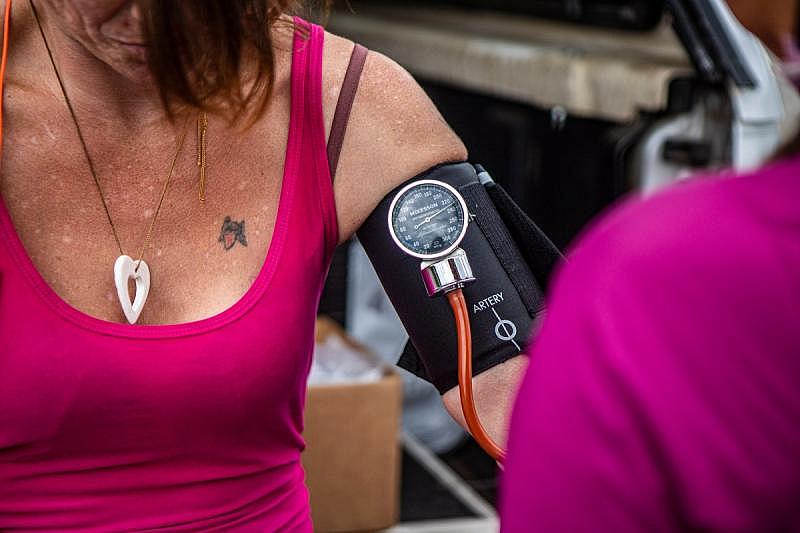
Anna Cummings checks Melissa’s vitals as they provide her street medicine in a parking lot in northwest Redding on Sept. 19, 2022. Melissa reached out to Health Outreach for People Everywhere (HOPE) for treatment for her syphilis.
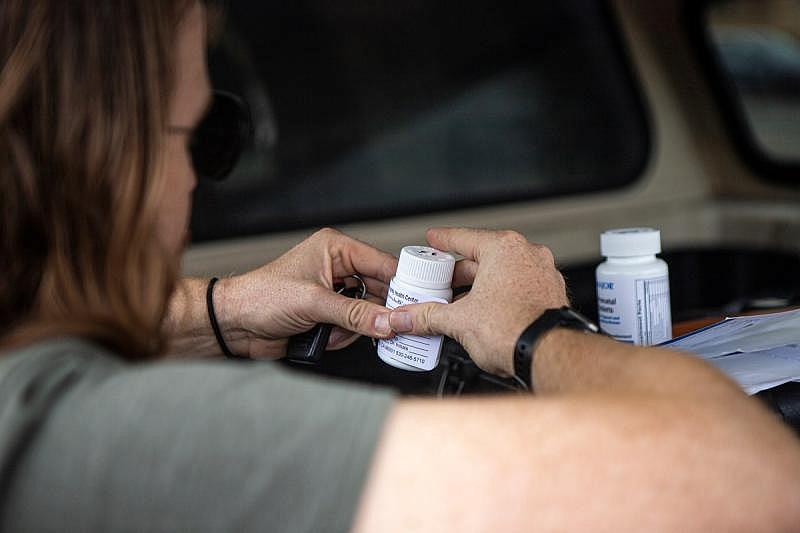
Dr. Kyle Patton reaches into the back of his truck to prescribe medication to patients he meets while driving around Redding on Sept. 19, 2022. Photo by Larry Valenzuela, CalMatters/CatchLight Local
While Cummings makes the call, Patton sits Melissa on the tail of the truck. They measure her oxygen level and take her blood pressure; it’s high. Patton gives her a plastic grocery bag with some canned food, beef jerky, menstrual pads and iron supplements. She’s still bleeding following her delivery.
“If you’re still bleeding in a couple weeks, let us know so we can check you out,” Patton tells her. “Do you need Narcan?”
“Always,” she says. “If not for me, then someone else.”
Narcan is a drug that can be used to reverse an opioid overdose. Patton offers her suboxone, a medication to help wean opioid dependence. She says she hasn’t used opiates like fentanyl in weeks, but is using meth.
“I’ve slipped like three times, but they’ve been weeks apart,” Melissa says.
While conversations about addiction frequently focus on opioids, methamphetamine use and overdoses have also been on the rise across the country. In California, emergency department visits from non-fatal amphetamine overdoses doubled between 2010 and 2020, according to the California Health Care Foundation, and deaths have also increased.
Oftentimes, substance use, homelessness and trauma precipitate one another, creating a sticky web that’s tough for people like Melissa and Cassidy to escape. Since 2015, women with syphilis have been more likely than men to report meth use, according to the state health department.
“On the ground, what we are seeing is the needs of people are so magnified and so much more intense than they were a decade ago,” said Dr. Dominika Seidman, an obstetrician and gynecologist at UCSF and Zuckerberg San Francisco General Hospital.
Seidman has worked with unhoused pregnant patients in San Francisco since 2013. As patient needs grew, UCSF and San Francisco General Hospital created a program called Team Lily that provides social services and medical care for pregnant people. As part of Team Lily, Seidman works alongside social workers, housing and substance use navigators and psychiatrists.
“Back then we didn’t have as many people dropping into labor and delivery triage who were unsheltered and had so many competing needs at the same time,” Seidman said.
Pregnant women who use drugs and are at risk of sexually transmitted diseases face double the stigma and shame, ultimately preventing them from seeking out medical help.
“A lot of our women that are pregnant on the street are also substance users. And so there’s a lot of shame and avoidance around that,” Patton, from Shasta Community Health Center’s HOPE team, said. “My patients care about their babies. They feel judged, and they worry about their baby and some of the effects on their baby as a result of their substance use. And so it can be challenging in those situations to really ask for help.”
Patton said his medical practice is about harm reduction. He tells patients that his truck full of medication, diagnostic tools, food and water is a “judgment free zone.” He wants all of his patients, and pregnant women in particular, to know that regardless of their ability to overcome their addiction or social situation in that moment, he can do things to help keep their baby safe.
“Treating STDs is a perfect example of that. We can screen for syphilis in our pregnant women and we can treat them. And that’s a moment where a sentinel event can be prevented,” he said, referring to serious but preventable health events that serve as a warning sign that something is amiss in the system, be it poor health care or inadequate access to care. Congenital syphilis is considered a sentinel event in public health.
More testing; less stigma
That work on the streets is more important than ever. Despite state requirements, experts and public health officials say not enough testing is happening, in large part due to stigma and the way medical professionals were trained for decades to think about sexually transmitted infections.
“The thing is, unless they’re considered ‘high risk,’ then you’re not testing them. And what do you consider high risk? We become about judging, and judging needs to go out of medicine,” said Vardit Lichtenstein, office manager at the California Pregnancy Center in Fresno, which treats about 40% of the county’s maternal and congenital syphilis cases.
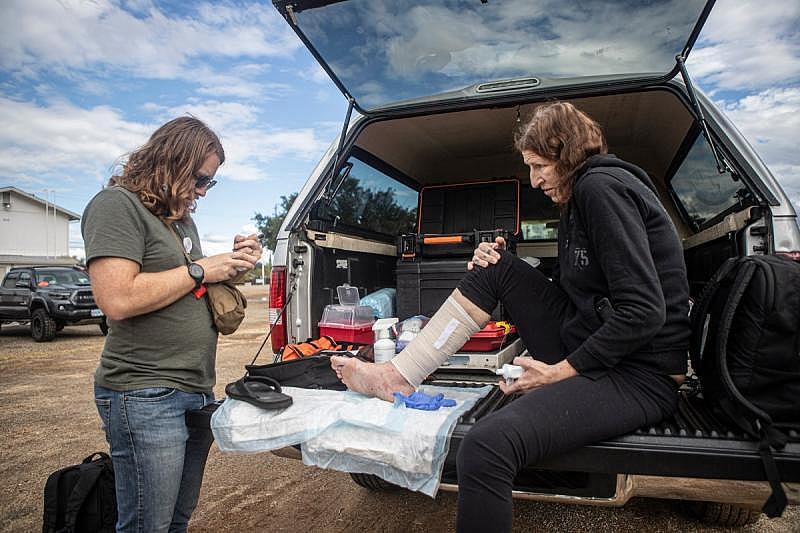
Dr. Kyle Patton bandages a sore on a patient’s leg in the back of his truck on Sept. 19, 2022 and prescribes her antibiotics. Later, test results will show that the sore is a symptom of late-stage syphilis. Photo by Larry Valenzuela, CalMatters/CatchLight Local
Dr. Ron Lichtenstein, her husband, saw his first maternal syphilis case 15 years ago. The 16-year-old patient was white, blond with blue eyes and attended the same high school as his daughter. She was from “the right side of town,” Lichtenstein said. She had an odd lesion that he didn’t want the baby to come in contact with, so he scheduled her for a C-section and further testing.
“The results came back. She had syphilis. You know, you could have blown me over with a feather,” he said.
After that, he and his wife made it standard practice to test every patient that comes through their doors for syphilis regardless of socioeconomic status long before the state required all doctors to do so. They built a strong relationship with the Fresno County Department of Public Health to offer treatment to patients from across the county. Vardit has become a local expert in managing syphilis cases.
“It doesn’t discriminate (but) there is still this stereotyping that goes on among some of our colleagues,” Ron Lichtenstein said.
Across the state, as funding for public health dwindled and Affordable Care Act money increased, treatment and testing services for sexually transmitted infections were pushed from public health to primary care facilities where clinicians weren’t trained to have in-depth conversations about sexual health and risk factors.
In many areas of the state, the transition from public health to primary care as the main source of sexual health assessment came with a price: closure of free STD clinics, loss of walk-in appointments, less public awareness of where to get tested, and from some providers an unwillingness to talk openly about sexual health and risk factors without judgment. In short, more barriers.
“We’re really challenged with sometimes hearing from our own stakeholders that they have difficult experiences with providers, depending on the provider’s experience or willingness to talk about sexual health,” said Everardo Alvizo, HIV/STD strategic implementation specialist for the Long Beach Department of Health and Human Services.
Long Beach opened its sexual health clinic a few years ago, but primary care still provides the bulk of services. Alvizo said training primary care providers to talk to patients about sexually transmitted infections without increasing stigma is often overlooked. Part of his job is to form those connections, but like many public health workers across the state, he wishes his team were bigger.
In order to stop the congenital syphilis outbreak, experts say recommendations for routine syphilis testing need to stretch beyond pregnant patients. Most adult men are never tested, and women only get screened for chlamydia and gonorrhea every few years if they see the doctor for a pap smear. Lichtenstein said the last time he was tested for syphilis was in 1982 when he immigrated to the U.S.
Dr. Christine Mirzaian, a pediatrician at Children’s Hospital Los Angeles who works with teens and high-risk infants, said routine syphilis testing is only recommended for gay boys and men.
“It’s important to have a lower threshold for looking for it, because clearly it’s out there much more than it was previously,” Mirzaian said.
Non-compliance is a ‘cop-out’
The next day in Redding, in the empty lot behind the Raley’s grocery store, Cummings rolls a syringe of penicillin between her hands before attaching a needle. The thick, white antibiotic makes for a particularly painful injection.
“Sorry. I know,” Cummings says as Melissa grimaces from the shot. “Almost done.”
It turns out, Melissa did complete the full syphilis treatment during her pregnancy, but her partner wasn’t treated, meaning she is most likely reinfected.
“I’ll call him so that you don’t have to have that conversation with him,” Cummings says. They send Melissa off with another bag of food and plans to bring her a new sleeping bag later in the day to replace the bedding that got soaked in the previous night’s storm.
The traditional health care system doesn’t allow clinicians to spend much more than 15 minutes with each patient — not enough time to get a sense of the full scope of their needs — and it certainly doesn’t allow them to hit the pavement looking for patients, like the HOPE team in Redding. Too often, vulnerable patients like Melissa are marked as “non-compliant” or “lost to follow up.”
“There are so many other things that could be happening. Even if you are housed, whether it’s a domestic violence situation, or transportation, or they just can’t get time off work. Because of those competing factors, their health isn’t their top priority,” Patton said.
Recently, Shasta County Health and Human Services budgeted $300,000 to purchase a mobile clinic van to expand primary care for hard-to-reach populations. Since 2019, the department has gotten an additional $170,000 per year from the state to address sexually transmitted infections. But there’s still a need to increase testing and treatment capacity in the field as well as a desire among staff to more seamlessly integrate the health department with other county services that address mental health, housing and substance use.
As homelessness worsens in the state and people’s needs increase, the health care system needs to change to become more interdisciplinary and accessible to people facing multiple barriers, Patton said.
“To some degree that’s a cop-out for us in health care to just say ‘you’re noncompliant’ and to not engage or problem solve with our patients in regards to some of their more complicated social factors,” Patton said.
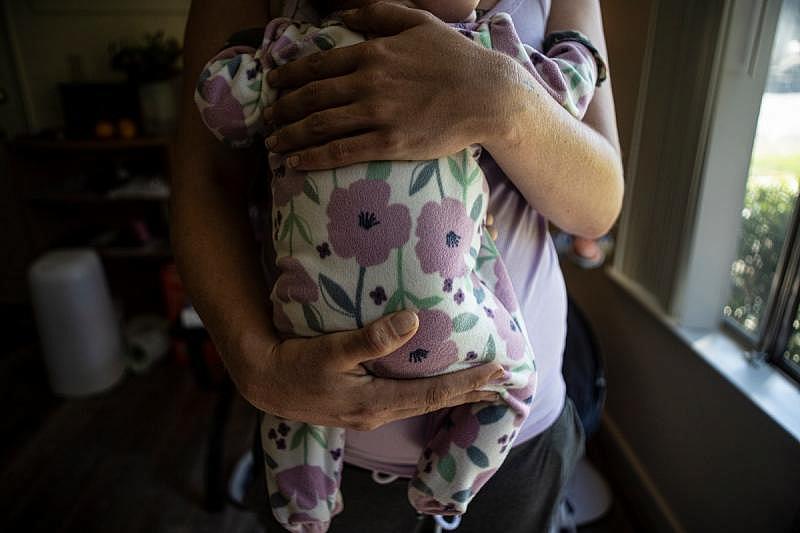
Cassidy holds her child in her apartment in Redding on Sept. 20, 2022. Earlier that day, Cassidy graduated from an intensive outpatient substance treatment program after being sober for nine months and one week. Photo by Larry Valenzuela, CalMatters/CatchLight Local.
A few miles away in a two-story apartment complex, Cassidy cradles her daughter in her arms. She has big blue eyes and looks a lot like Cassidy did as a baby.
“I love you,” she whispers.
Earlier in the day, Cassidy graduated from an intensive outpatient substance treatment program. She has been sober for nine months and one week. Waking up to her daughter instead of a bottle of vodka is freeing — Cassidy says it gives her the motivation she needs to stay sober.
“I want to be the clean and sober mom that she needs,” she said. “I want to be the best I can be for her, be there her whole life growing up. And I want to be clean and sober when my other daughter wants to come see me.”


